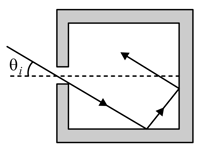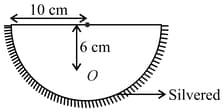Where is the secondary principal focus.
Important Questions on Reflection and Spherical Mirror
A monochromatic beam of light enters a square enclosure with mirrored interior surfaces at an angle of incidence (see the figure below). For some value(s) of , the beam is reflected by every mirrored wall (other than the one with opening) exactly once and exists the enclosure through the same hole. Which of the following statements about this beam is correct?

The image of an object due to reflection from the surface of a lake is elongated due to the ripples on the water surface caused by a light breeze. This is because the ripples act as tilted mirrors as shown below. Consider the case, where and the observer are at the same height above the surface of the lake. If the maximum angle that the ripples make with the horizontal is , then the angular extent of the image will be

A hemispherical glass body of radius 10 cm and refractive index 1.5 is silvered on its curved surface. A small air bubble is 6 cm below the flat surface inside it along the axis. The position of the image of the air bubble made by the mirror is seen :

A ray of light parallel to the principal axis of a spherical mirror falls at a point as shown in the figure below:

If the mirror is immersed in water, its focal length _____.
Assertion: A concave mirror of some focal length in air is used in a medium of refractive index Then the focal length of the mirror in that medium will remain the same.
Reason: The focal length of a mirror is half of the radius of curvature of the mirror.

